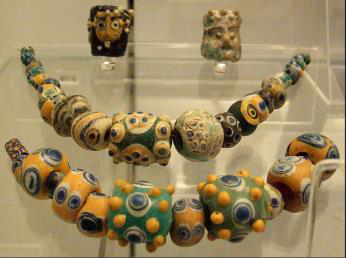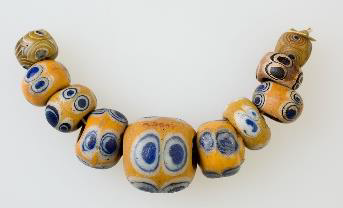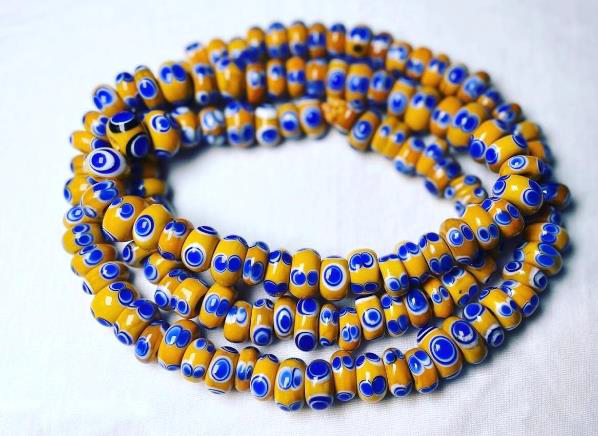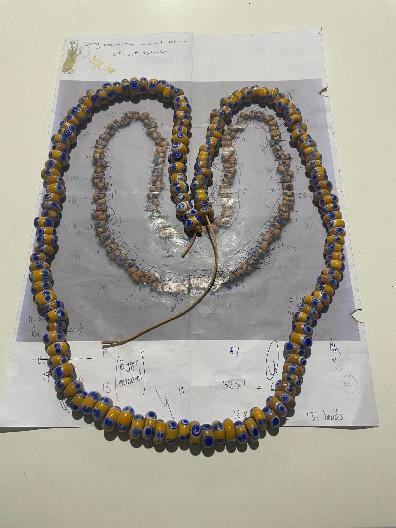Reproduction: Phoenician Glass Eye Beads, ca 330 BC-70 BCBaroness Ginevra Lucia Di Namoraza
Figure 1- Image of the recreation necklace- C Merritt
| Figure 2- Image of original necklace held by the MET |
What? 133 Glass eye beads forming a necklace. I’ve added two extra beads, as the originals were also found with the others, but one was broken and the other one went missing so they couldn’t be displayed.
Where? Phoenician
When? Hellenistic Period
Why? The glass eye beads are fascinating as they demonstrate exactly how beads were traded and how they made their way all over the world. You can also see how the same beads are made in many different time periods and cultures. I will include examples of the exact same bead (in terms of colours, dimensions, and decorations) so that you can see the extent to which they travelled locations and time. When looking at this “necklace” or “collection”, I have noticed several things about it which are fascinating on a scholarly level. Firstly, I believe they were made by several different people, including perhaps an apprentice. Secondly, considering how many there are in very similar forms, I wonder if they were made to sell at a market instead of worn by one person. Thirdly, I have worn the necklace as a double strand necklace, and it is comfortable, though I would say extravagant, and non-practical.
Details of the extant piece:
- The MET Museum¹ has the following information about the piece:
- Title: Glass eye beads Period: Hellenistic Date: ca. 330–70 B.C.
- Culture: Phoenician
- Medium: Glass
- Classification: Glass Credit Line: The Cesnola Collection, Purchased by subscription, 1874–76
- Myres and Christopher Lightfoot have the following additional information:
- Category: 509: String of eye beads
- Period: Archaic or Classical,
- Date: 6th–4th century B.C
- Culture: Phoenician.
- Size: Diameter of individual beads⅜–½ in. (1–1.3 cm
 |
| Figure 3- Image of a Phoenician woman wearing a similar necklace |
 |
Figure 4- Example of similar beads |
Description
Opaque yellow, with translucent blue and opaque white stratified eyes. String of 133 eye beads of various shapes, sizes, and designs, many comprising two beads fused together, and all having a large thread-hole. The stratified eye decoration is composed of a blob of opaque white with an overlay of a thin blue circle surrounding a large blue spot. All but one of the beads are intact, the exception having a chip to one side of the thread-hole; slight dulling, with deep pitting on a few of the central blue spots. The beads formed a necklace that probably had an apotropaic as well as a decorative purpose. Strings of similar beads are known from sites throughout the ancient world; for example, there are ten beads in the Department of Egyptian Art that were formerly in the collection of the Reverend Chauncey Murch, who was active as a missionary in Egypt between 1883 and 1906. Stated in the departmental records as comprising 135 beads².
String: There was no obvious material remaining to show what the beads were strung on, but organic material such as a leather or cotton cord would have been common.³
 |
Figure 5- Example of similar beads |
Details of the Recreation
I chose to recreate the 133 beads that are on display for historical accuracy. I worked with the MET museum's high- resolution image to recreate each bead with its unique characteristics. Each bead took me about 20 minutes of time to recreate, making the whole project about 60 hours of work, over 3 months.
As mentioned in Myers⁴, the diameter of the individual beads is 1-1.3 cm, and the hole of each bead is considerable. As such I used the 3.2 mm and 5mm sized mandrel which both track accurately with the sizing and shape of the beads.
I followed up with Christopher Lightfoot, the author of The Cesnola Collection of Cypriot Art: Ancient Glass, to double check the accuracy of the recreation. The measurements on the Met Museum website for the string did not make sense, and when I recreated the piece based on the sizing of the beads as well as the visual cues in photos of the extant beads, the measurement still did not work. I contacted Chris who worked at the museum as a Curator for thirty years. The museum pulled the piece out to check it and then updated the description so that it is now correct, based on my feedback. ( How cool!)
A point to note is that there is thousand-year-old wear on the beads that are on display. This means that whilst the bead may now appear quite square, they would have been rounder when freshly made. Colours and details are faded, and many of the beads have wear such as chips and odd rubbing marks etc. Interestingly, many of the beads appear to have frequent wear near the eye, which makes it seem as they were rubbed often there- this would make sense if the wearer believed that rubbing the eye would protect them from evil spirits
I have been working on developing my skill at melting glass and shaping it over the last year. I have learnt a lot, including where in the flame certain glass must be placed so that it doesn’t ruin the colour or texture. I have learnt how to steadily place my hands and rotate both glass and mandrel so that an even amount of glass, at the right temperature, is kept at the right heat to reproduce the desired bead.
The necklace presented a variety of challenges. Glass is a dangerous, sometimes fickle substance, and certain colours only work properly at a certain heat.
Some of the trickier techniques (and melting glass onto a mandrel and keeping it even is tricky to start with!) that I used for this project include:
- Studying each (photo of) bead in a variety of lights to get an accurate grasp of the details and finishes required.
- Working with tricky colours such as yellow, which can be easy to “burn” or mutate colour.
- Combining colours and the perfect melt down spot to get a more accurate shade and shape.
- Creating the beads with “eye” decoration in the right size and a number of blue and white circles.
- Ensuring that I copied the “flawed” beads as well, to accurately represent the extant pieces. As a perfectionist- trust me when I say this was possibly my hardest challenge!
- Shaping similar size beads but also recreating subtle differences such as size and shape.
- Creating stringers for finer detail in the small dots. One needs to carefully pull glass at a specific pace to achieve this.
- Certain shapes, such as the double eyes, require precise manoeuvring and shaping- the use of a knife needed to recreate the shape.
- Using techniques such as flattening the dots between each layer, melting them in completely before adding in the new layer, and then applying the final tiny circle.
 |
Figure 6 -10 beads from the Egyptian Department |
Something creatively unique
I included several beads that were created using the same materials available in the creation of the original necklace. I have arranged the colours in different ways and melted the dots in at different levels. As you can see, the result is quite different to the original, and I must say the original colour scheme is quite striking comparatively.
 |
Figure 7- A photo of the original beads |
 |
Figure 8- A photo of the reproduction beads |
Making the glass beads
- I used a graphite paddle, mandrels, bead release, a knife, fire annealing and gravity. I try to use the least tools possible and authentic equipment that would have been used by the glassmakers of the time. Apart from my fire set-up, all the equipment I have used would have been used at the time as well.
- Clear broken glass was often used as well as imported blocks of coloured glass⁵.
- The glass rods I used to recreate these beads were Effetre Murano – 104 COE soft glass rods.
- This is a close replica of the glass that would have been used at the time.
- Bead artisans would have created a small kiln or furnace. The broken recycled glass would be put into the furnace through holes in the side to melt in a dish inside the furnace. Air was pumped into the furnace to keep the charcoal hot.⁶
- I use a hot head torch and MAPP gas. In the future I have plans to recreate a small portable kiln but melting glass in a small kiln is very difficult as getting the heat hot enough to melt the glass is a struggle.
- Metal rods (mandrels) were dipped with a clay mixture called bead release. The molten glass is wound onto the rod until the desired shape was achieved. Once the bead size and shape were achieved, a design could be added by heating thin bits of glass and wrapping them around the bead, with a “stringer” that was heated and laid on top.⁷
- I use mandrels that would have been very similar to those used, however, mine are shorter as they don’t need to be as long to reach into a hot fire. The bead release I use has the crucial ingredients of water, kaolin and alumina hydrate, which is a composition that would have been used.
- Beads would then be moved to an annealing dish in the furnace. This would prevent thermal shock, lowering the chances of the bead cracking.
- Instead of annealing them in a furnace, I use a product called vermiculite to allow the beads to cool down slowly. I also use a kiln. In the future, I would like to try annealing them in a furnace to see what it is like.
- After the beads are finished, I remove them from the mandrels, clean them out with some bead cleaning tools and give them a quick clean with some soapy water.
- I included a selection of creative beads using the resources that would have been available to make this necklace. As you can see, the original colour layout is more striking in colour.
 |
Figure 9- After a long session and fresh off the mandrel |
 |
Figure 10 - The beads I made and my trusty printed photo of the original beads |
Future Projects
- In the future, I would like to practice more difficult skills, e.g., fine line work and millefiori use.
- For this project, I would match the sizes even more accurately as well as the colour and opacity.
- I am enjoying creating pieces from different times and cultures and I will continue to develop my skills by choosing challenging projects.
- I also enjoyed working with the museum and the professor, and I would like to continue working with people like this. Not only was it very educational and rewarding, but it resulted in me contributing to the historical accuracy of the museum- which I thought was super cool!
- I also intend to work on another historical recreation of a glass making set up.
 |
Figure 11- Worn as a double strand- glass is weighty but feels nice. |
 |
Figure 12- The strand is quite long! |
Resources
Primary Resources:
High-Resolution Copy of the extant necklace: https://www.metmuseum.org/art/collection/search/239901
Secondary Resources:
- Guido, Margaret. The Glass Beads of Anglo-Saxon England: c. AD 400-700, Boydell Press, 1999.
- Holgate, Barbara. “The Pagan Lady of Peel”, St. Patrick’s Isle Archaeological Trust, 1987.
- Holst, Sanford and Khoury Harb. Phoenicians” Lebanon’s Epic Heritage, 2021.
- Karageorghis, Vassos, Joan Mertens, and Marice E. Rose. Ancient Art from Cyprus: The Cesnola Collection, 2000.
- Lightfoot, Christopher S. "Metropolitan Müzesi, Cesnola Koleksiyonu’nda Yeralan Kıbrıs Cam Eserleri." 2013.
- Lightfoot, Christopher S. The Cesnola Collection of Cypriot Art: Ancient Glass, 2017. Myres, John
- L. Handbook of the Cesnola Collection of Antiquities from Cyprus, 1914. Regia Anglorum:
- https://regia.org/
Image credits
Figure 1 Image of original necklace held by the MET Met Museum
Figure 2 Image of the recreation necklace- C Merritt Carina Merritt
Figure 3 Image of a Phoenician woman wearing a similar necklace Sanford Holst
Figure 4 Example of similar beads https://archaicwonder.tumblr.com/
Figure 5 Example of similar beads flickr.com/photos/kotomi-jewelry/
Figure 6 10 beads from the Egyptian Department Met Museum
Figure 7 A photo of the original beads Christopher Lightfoot
Figure 8 A photo of the reproduction beads Carina Merritt
Figure 9 After a long session and fresh off the mandrel Carina Merritt
Figure 10 The beads I made and my trusty printed photo of the original beads Carina Merritt
Figure 11 Worn as a double strand- glass is weighty but feels nice. Carina Merritt
Figure 12 The strand is quite long! Carina Merritt


To save the next person a moment with the dictionary: apotropaic = "supposedly having the power to avert evil influences or bad luck." Great article, well done! It looks wonderful in person.
ReplyDeleteThank you!
ReplyDeleteThis is so beautiful! I was sent to your blog by Baroness Kolfinna, I've been looking into lampwork and admired the beads you did for Tocal. Hopefully we can meet in the future 🌙👁
ReplyDelete